SomeaKenya provides Updated and Revised notes for the current CPA syllabus. Revision kits (Past papers with answers) are also available to help you with revision of the upcoming exams. You can get these materials in Hardcopies (Printed and Binded) and also available in Softcopy form when you subscribe on mobile or Desktop/Laptop someakenya Application. (Note: Softcopies are not Printable and can only be read using android phones) Click here to download SOMEAKENYA APP from Google Playstore.
Full Access to these notes/Kit on Desktop/Laptop via https://desktop.someakenya.co.ke
Or through Our Mobile App
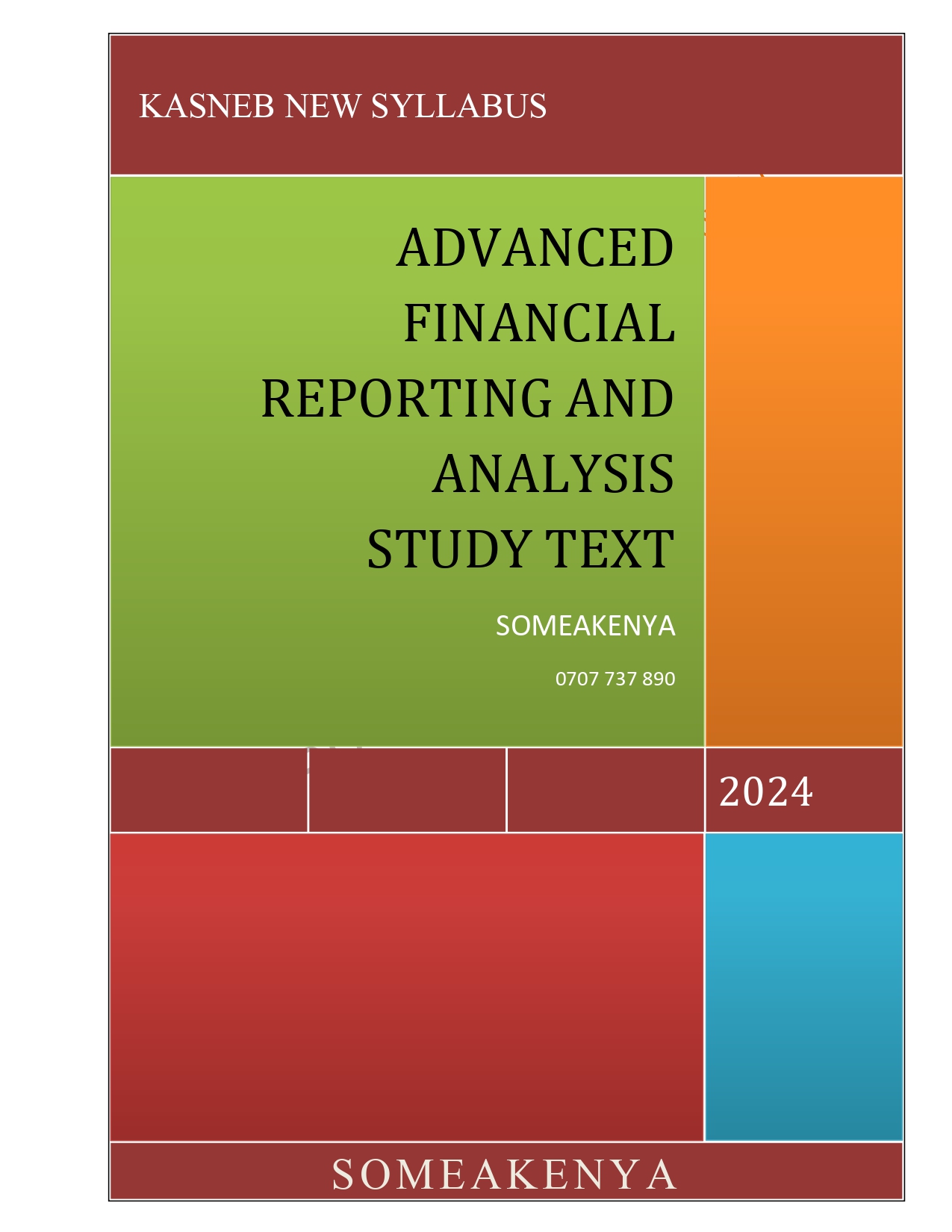


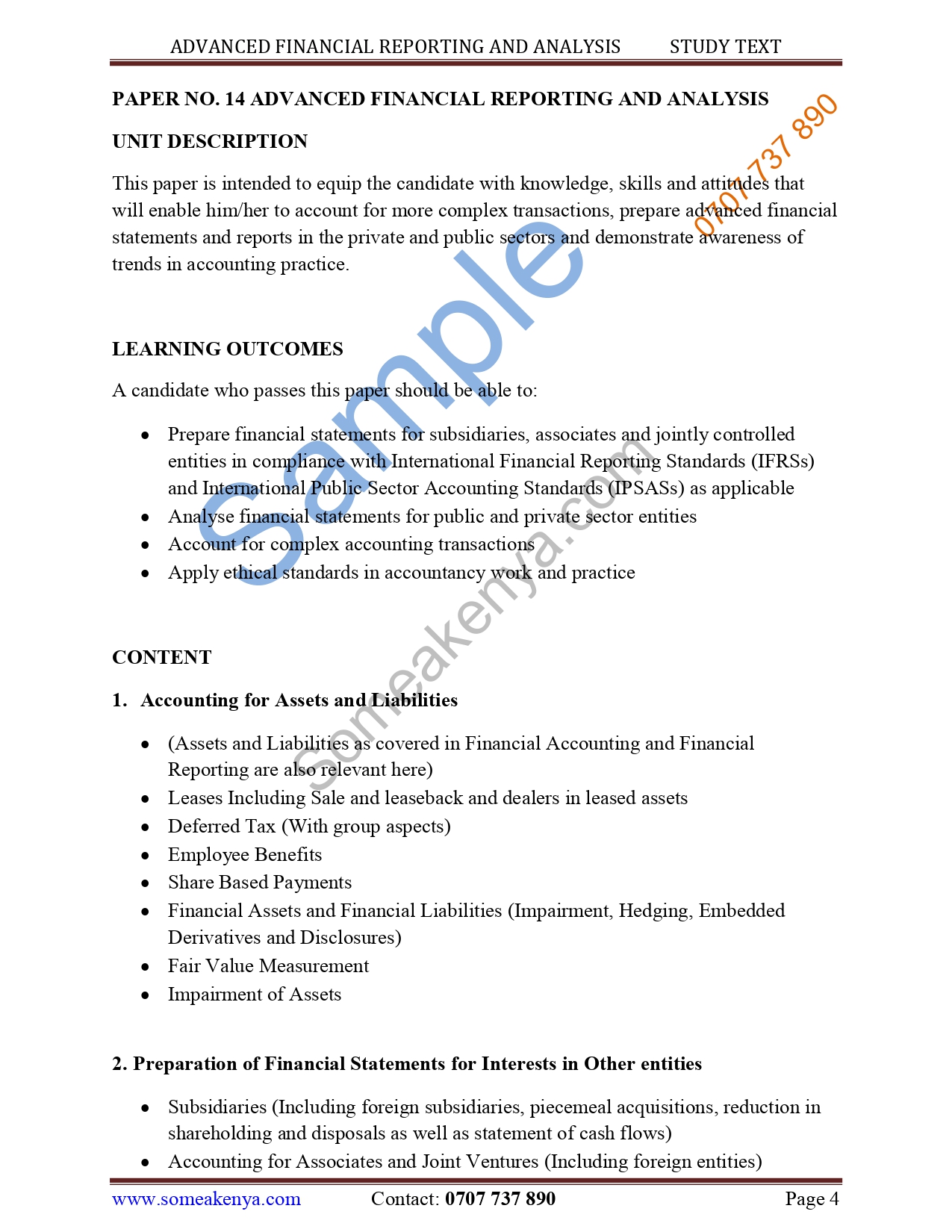

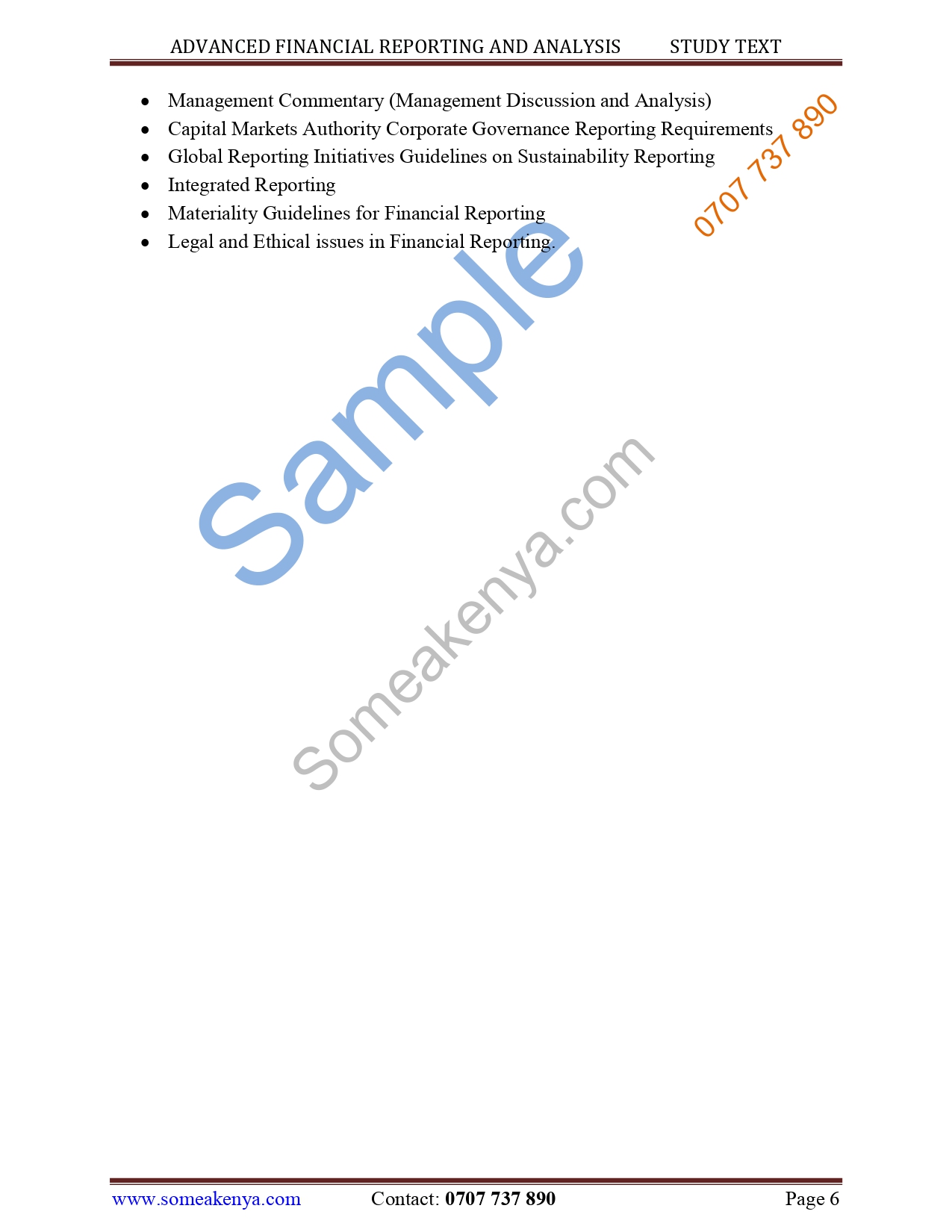
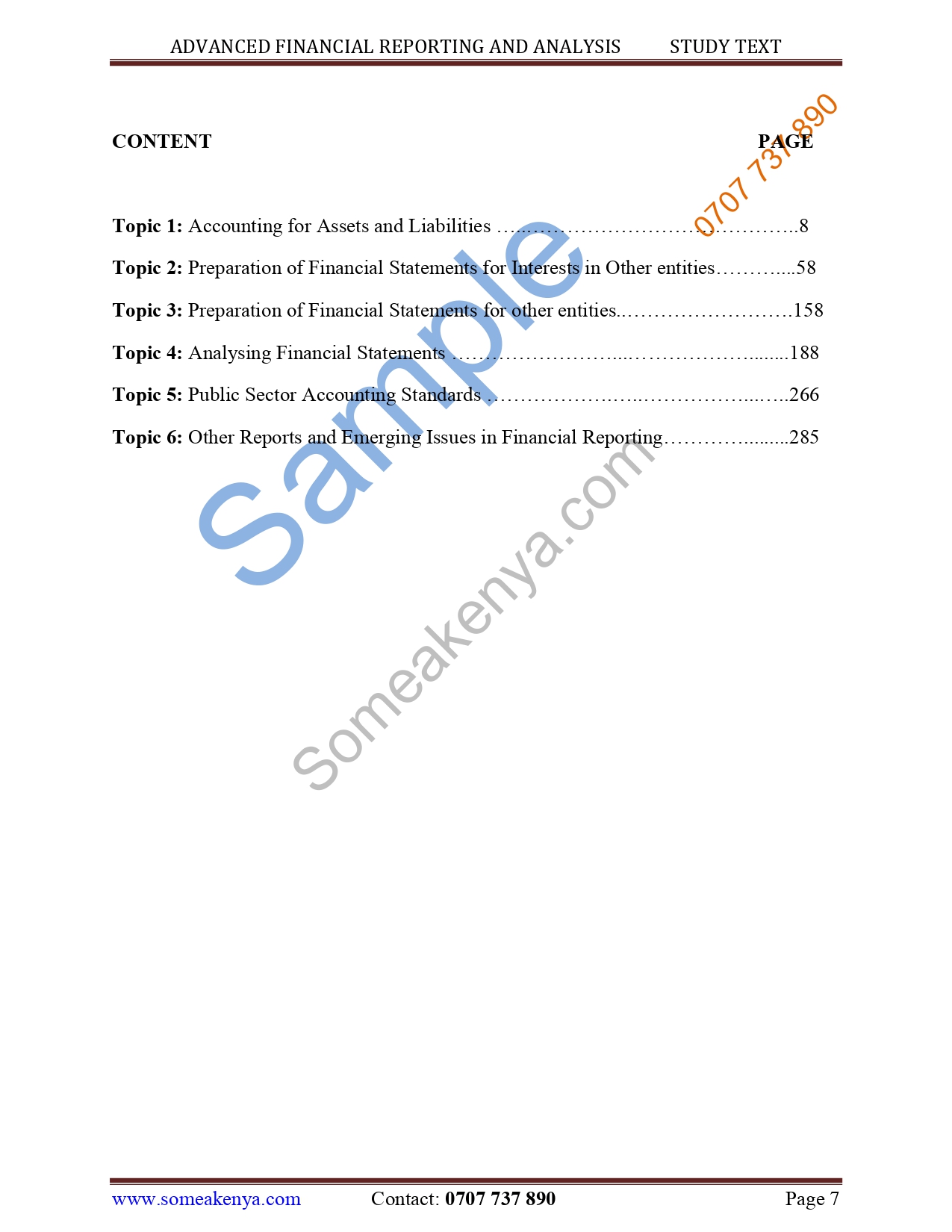
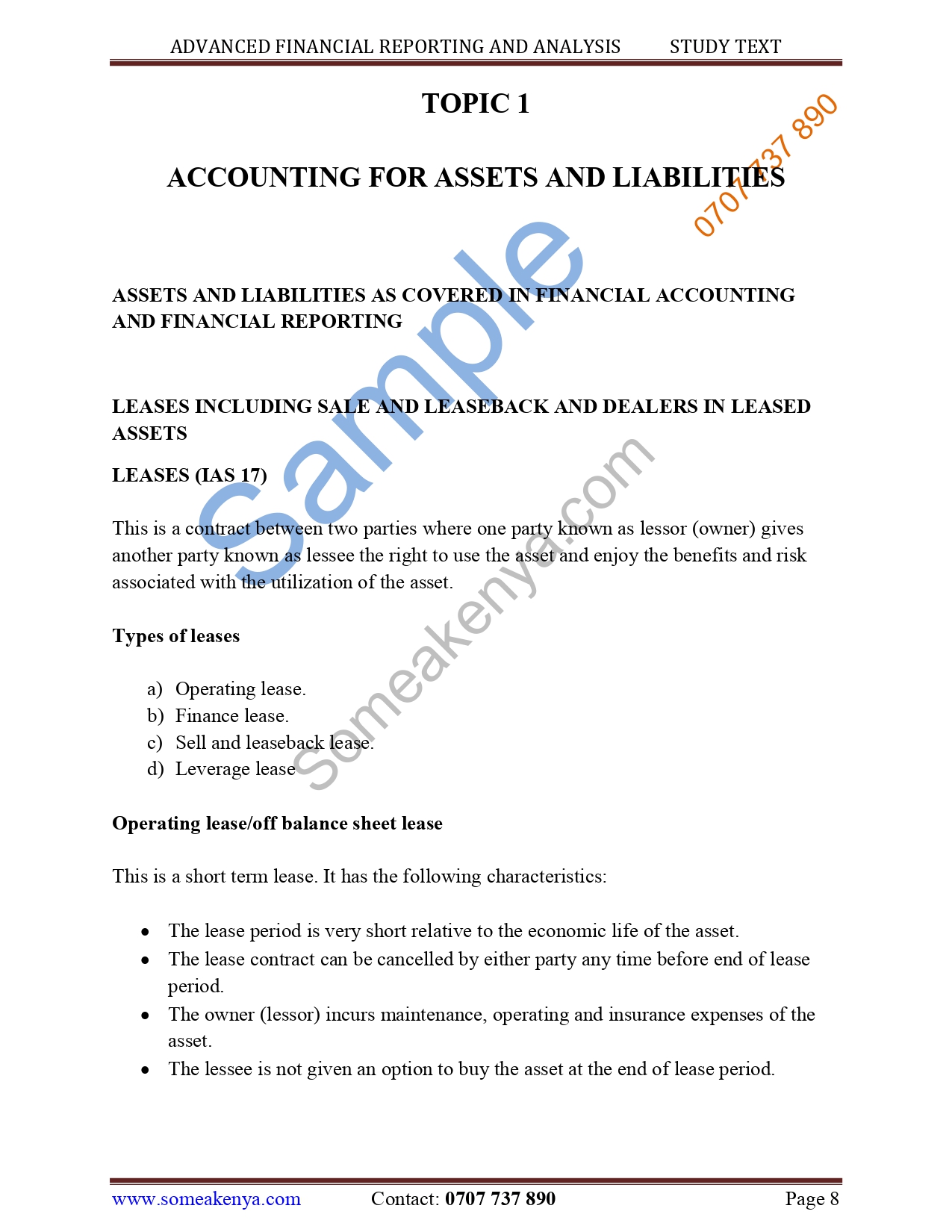
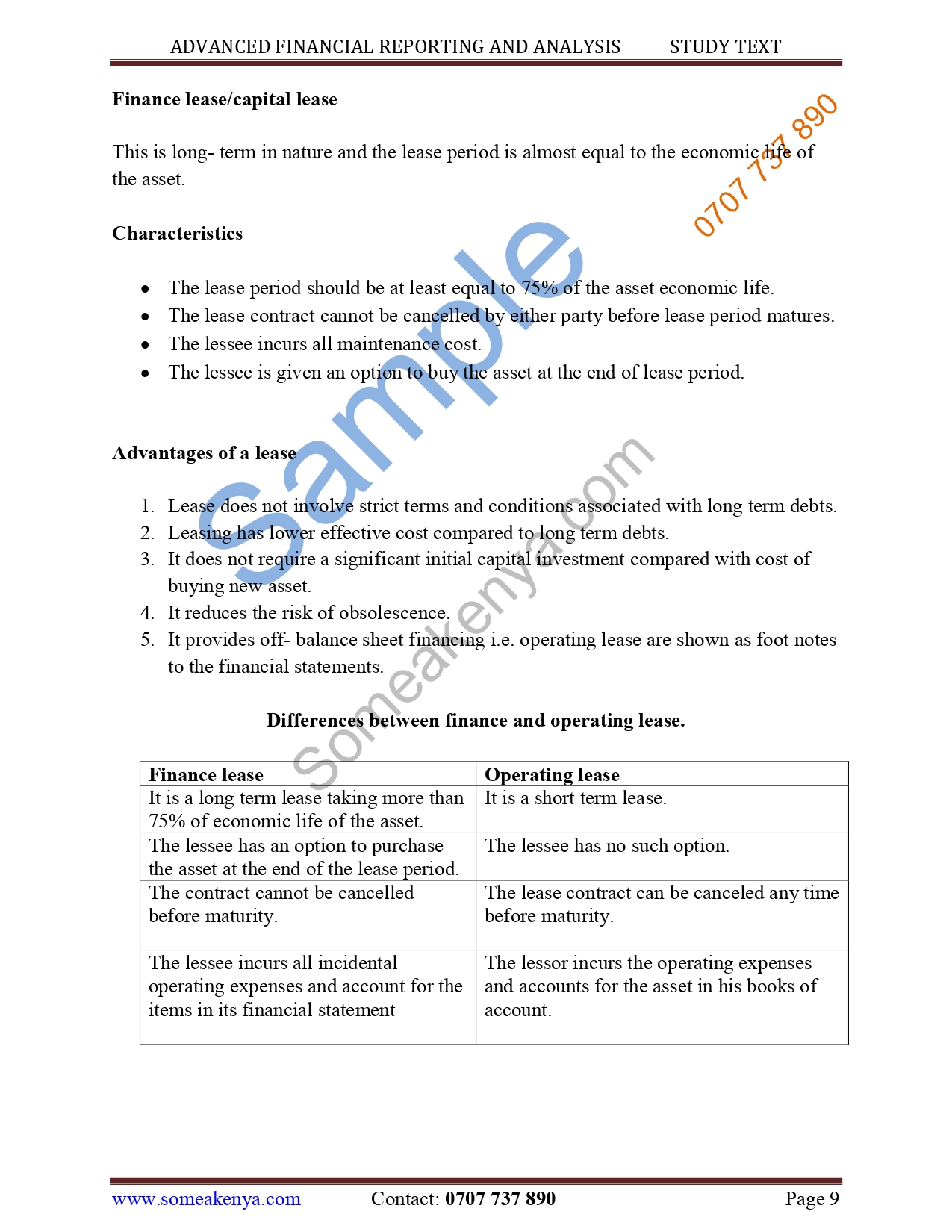
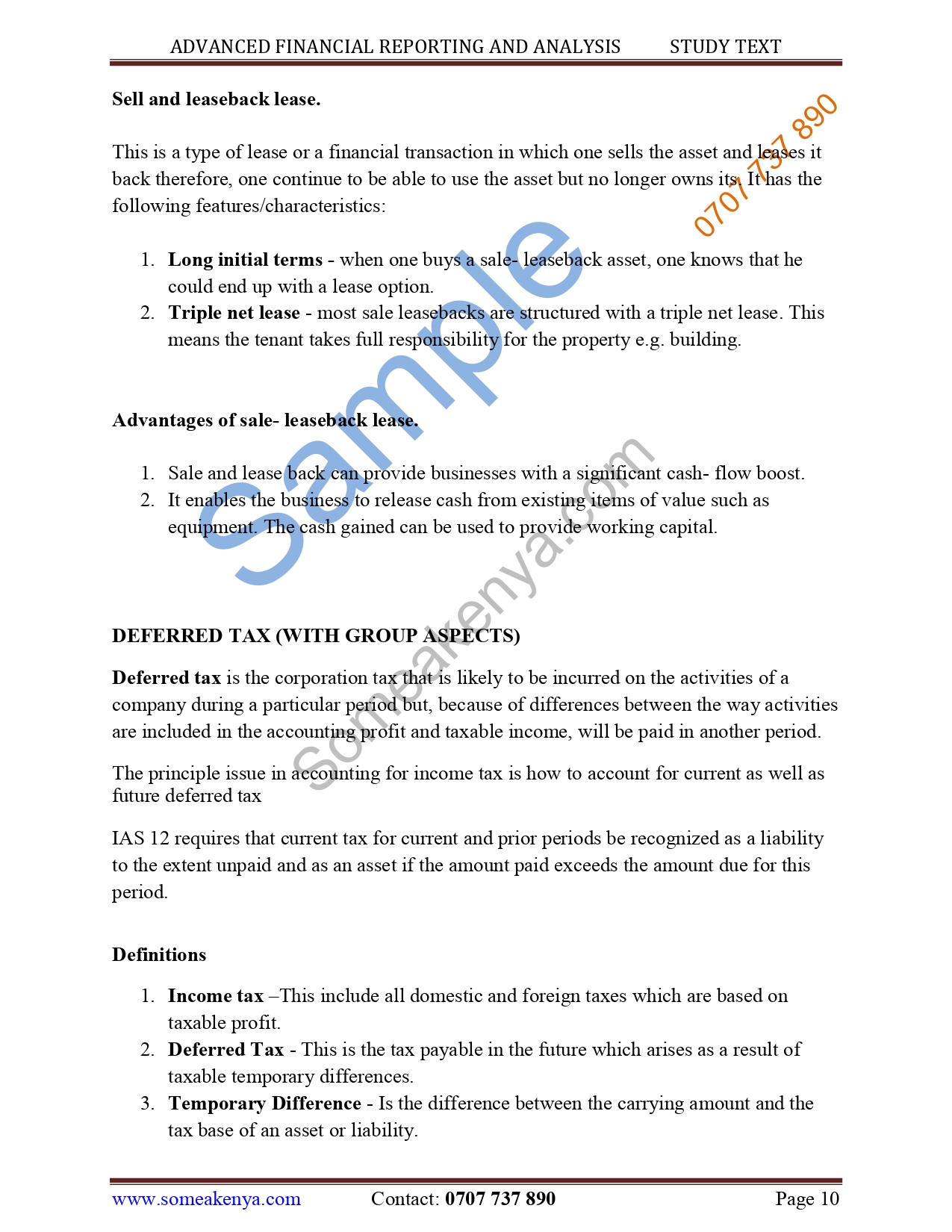
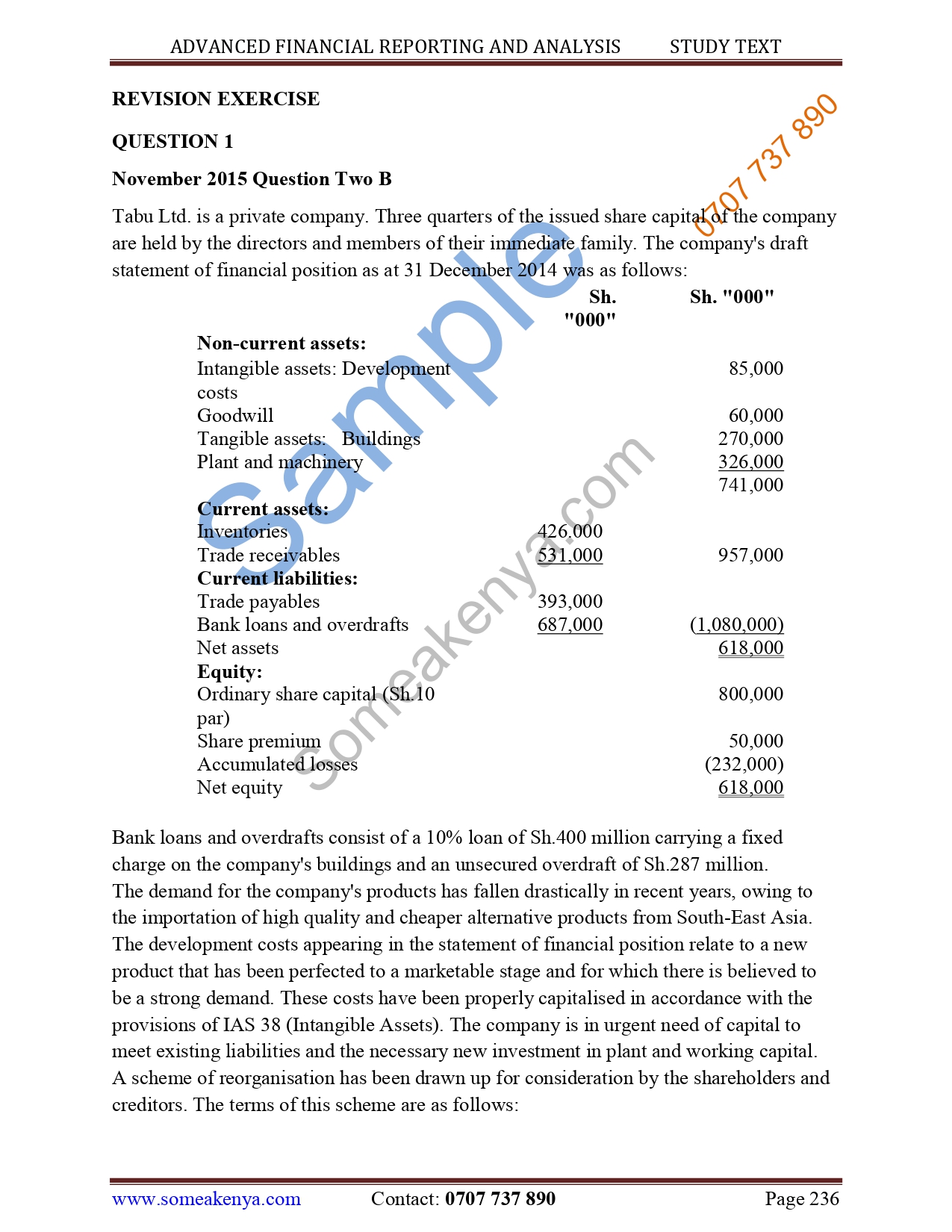





Full Access to these notes/Kit on Desktop/Laptop via https://desktop.someakenya.co.ke
Or through Our Mobile App
TOPIC 1
ACCOUNTING FOR ASSETS AND LIABILITIES
ASSETS AND LIABILITIES AS COVERED IN FINANCIAL ACCOUNTING AND FINANCIAL REPORTING
LEASES INCLUDING SALE AND LEASEBACK AND DEALERS IN LEASED ASSETS
LEASES (IAS 17)
This is a contract between two parties where one party known as lessor (owner) gives another party known as lessee the right to use the asset and enjoy the benefits and risk associated with the utilization of the asset.
Types of leases
Operating lease.
Finance lease.
Sell and leaseback lease.
Leverage lease
Operating lease/off balance sheet lease
This is a short term lease. It has the following characteristics:
The lease period is very short relative to the economic life of the asset.
The lease contract can be cancelled by either party any time before end of lease period.
The owner (lessor) incurs maintenance, operating and insurance expenses of the asset.
The lessee is not given an option to buy the asset at the end of lease period.
Finance lease/capital lease
This is long- term in nature and the lease period is almost equal to the economic life of the asset.
Characteristics
The lease period should be at least equal to 75% of the asset economic life.
The lease contract cannot be cancelled by either party before lease period matures.
The lessee incurs all maintenance cost.
The lessee is given an option to buy the asset at the end of lease period.
Advantages of a lease
Lease does not involve strict terms and conditions associated with long term debts.
Leasing has lower effective cost compared to long term debts.
It does not require a significant initial capital investment compared with cost of buying new asset.
It reduces the risk of obsolescence.
It provides off- balance sheet financing i.e. operating lease are shown as foot notes to the financial statements.
Differences between finance and operating lease.
Finance lease Operating lease
It is a long term lease taking more than 75% of economic life of the asset. It is a short term lease.
The lessee has an option to purchase the asset at the end of the lease period. The lessee has no such option.
The contract cannot be cancelled before maturity. The lease contract can be canceled any time before maturity.
The lessee incurs all incidental operating expenses and account for the items in its financial statement
The lessor incurs the operating expenses and accounts for the asset in his books of account.
Sell and leaseback lease.
This is a type of lease or a financial transaction in which one sells the asset and leases it back therefore, one continue to be able to use the asset but no longer owns its. It has the following features/characteristics:
Long initial terms – when one buys a sale- leaseback asset, one knows that he could end up with a lease option.
Triple net lease – most sale leasebacks are structured with a triple net lease. This means the tenant takes full responsibility for the property e.g. building.
Advantages of sale- leaseback lease.
Sale and lease back can provide businesses with a significant cash- flow boost.
It enables the business to release cash from existing items of value such as equipment. The cash gained can be used to provide working capital.
DEFERRED TAX (WITH GROUP ASPECTS)
Deferred tax is the corporation tax that is likely to be incurred on the activities of a company during a particular period but, because of differences between the way activities are included in the accounting profit and taxable income, will be paid in another period.
The principle issue in accounting for income tax is how to account for current as well as future tax deferred tax.
IAS 12 requires that current tax for current and prior periods be recognized as a liability to the extent unpaid and as an asset if the amount paid exceeds the amount due for this period.
Definitions
Income tax –This include all domestic and foreign taxes which are based on taxable profit.
Deferred Tax – This is the tax payable in the future which arises as a result of taxable temporary differences.
Temporary Difference – Is the difference between the carrying amount and the tax base of an asset or liability.
Tax Base – Is the amount attributable to an asset or liability for the tax purposes/amount allowable for tax purposes in the future.
Taxable temporary Differences – This are temporary differences that will result in deferred tax liability.
Deductible temporary Differences – This are temporary differences that will result in deferred tax asset.
Deferred tax liability – these are amount of income taxes payable in future period in respect of taxable temporary difference.
Deferred tax asset – these are amount of income taxes recoverable in future period in respect of deductible temporary difference.
Deferred tax is the estimated future tax consequences of transactions and events recognised in the financial statements of the current and previous periods. The need for deferred tax arises because the profit for tax purposes may differ from the profit shown in the financial statements.
The difference between accounting profit and taxable profit is caused by:
Temporary differences
Permanent differences
Deferred tax is a means of “ironing out” the tax inequalities arising from temporary differences.
Temporary Differences
These are differences between the carrying amount of an asset or liability in the statement of financial position and the tax base of the asset or liability. The tax base is the amount attributed to that asset or liability for tax purposes (often known as the Tax Written Down Value).
A temporary difference arises when an item is allowable for both accounting and tax purposes, but there is a difference in the timing of when the item is dealt with in the accounts and when it is dealt with in the tax computations.
A common example of such a difference is capital expenditure. In the financial statements, the expenditure will be depreciated over the life of the asset and this depreciation will be deducted in arriving at accounting profit. However, in the tax computation, depreciation is not deductible. It is added back and capital allowances (or tax depreciation) are granted instead. If the accounting depreciation and capital allowances are calculated at a different rate, there will be a difference between the accounting profit and the taxable profit.
This is a temporary difference because eventually, the cause of the difference will disappear entirely.
That is, the asset will eventually be fully depreciated and no further depreciation expense in respect of that asset will appear in future income statements and all capital allowances will also have been claimed, leaving no further deductions in future tax computations in respect of the asset.
Permanent Differences
Some income and expenses may not be chargeable / deductible for tax and therefore there will be a permanent difference between accounting and taxable profits. That is, the difference will not reverse in the future
Therefore, permanent differences are:
One-off differences between accounting and taxable profits caused by certain items not being taxable / allowable
Differences which only impact on the tax computation of one period
An example of a permanent difference would be fines or penalties, such as interest imposed on the late payment of tax. Such an expense would appear in the financial statements but would not be allowable for tax purposes.
Deferred tax arises in respect of temporary differences only. Deferred tax is not concerned with permanent differences.
Basis of measuring for current tax and deferred tax
Tax expense for the period is made up of two elements:
Current tax
Deferred tax.
Current tax is the tax for the period based on the taxable profit for the year ie (gross income-allowable expenses).
Deferred tax on the other hand arises as a result of temporary differences. Increase in deferred tax is an expense which increases the tax liability for the year while a decrease in deferred tax is an income hence reducing the tax liability for the period.
Methods of determining income taxes
There are various methods of determining income tax for the period. The method may be grouped into 2 categories as follows:
1. Tax payable method/flow through method/nil provision method.
This approach considers income tax as an appropriation of income and not as an operating expense.it only recognizes current tax hence ignoring the deferred tax.
IAS 12 does not require the use of this method.
2. Deferred tax accounting method / Liability Method
Under this method, the tax expenses comprise both current and deferred tax. The deferred tax element in tax expense can be calculated using:
Full provision basis.
Partial provision basis.
Full provision method – this method requires that all temporary differences be recognized in full for all transactions accruing for a given period.
This method minimizes the subjection/biasness’ in provision of deferred tax because deferred tax is provided on all temporary differences.
Partial provision method – under this, the temporary difference be recognized for those that are reasonable of reversing in the future.
Argument for recognizing deferred tax/advantages of deferred tax recognition.
If deferred tax liability is ignored, profits will be inflated.
The accrual concept requires tax to be matched with profit as they are earned.
Deferred tax will eventually become an actual tax liability.
Ignoring deferred tax overstates profits which may result in:
Overpayment of dividend based on inflated profits.
Distortion of EPS and the P/E ratio hence distorting entities performance.
Shareholders are misled.
The need for deferred taxation arises in a number of ways
The figures used to calculate stock market indicators such EPS and P/E ratio require the computation of profit-after tax.
Deferred tax is important in establishing the relationship between shareholder’s funds and other sources of finance.
It also ensures compliance with the fundamental accounting concept of accruals.
It reports a tax liability which is likely to arise in the future.
It provides the post-tax profits that can be used to assess a suitable dividend declaration.
Calculation of Deferred Tax
Deferred tax is calculated using the liability method. Under this method, deferred tax is calculated by reference to the tax base of an asset (or liability) compared to its book value. IAS 12 requires full provision for all taxable temporary differences (except goodwill).
The following steps should be followed:
Calculate the temporary difference
Apply the tax rate to the temporary difference
The resulting tax liability (or asset) is shown in the Statement of Financial Position and the increase or decrease on the previous period is reflected in the Income Statement, as part of the tax figure (unless it relates directly to a gain or loss that has been recognised in equity, e.g. revaluations, in which case the deferred tax is also recognised in equity)
Deferred Tax Liabilities
IAS 12 requires that a deferred tax liability must be recognised for all taxable temporary differences (with minor exceptions). A taxable temporary difference arises where the carrying value of an asset is greater than its tax base.
Deferred Tax Assets
IAS 12 requires that deferred tax assets should be recognised for all deductible temporary differences. A deductible temporary difference arises where the tax base of an asset exceeds its carrying value. The deferred tax asset will be recognised to the extent that taxable profit will be available against which the deductible temporary difference can be utilised.
Tax Rate
The tax rate in force (or expected to be in force) when the asset is realised or the liability is settled should be used to calculate deferred tax.
This rate must be based on tax rates and legislation that has been enacted or substantively enacted by the reporting date.
Deferred tax assets and liabilities should not be discounted to present value.
Note:
Increase in deferred tax is an example while a decrease is an income
Revaluation changes of PPE AND AVAILABLE for sale asset have a special deferred tax treatment
Tax expense comprises current tax for a period and changes in deferred tax
Tax expense
Current tax XXX
Deferred tax(increase/decrease) XX(XX)
XXX
The Basis of Deferred Taxation
From the accountant’s viewpoint there are two quite distinct profit figures:
(a) Accounting profit – That is the profit reported to the shareholders. This profit is based on accounting concepts and principles.
(b) Tax-adjusted profit – That is the profit on which tax is assessed – taxable income (tax loss). This profit is determined in accordance with the rules laid down in the Income
Tax Act upon which the provision for taxes payable is determined. This profit takes into account capital allowances, stock relief, and disallowable expenditure and so on.
The reasons why these profits may differ fall into two groups of differences.
(a) Timing Differences – that is items reported in the accounts in periods different from those in which they are reflected in tax computations. These differences originate in one period and reverse in one or more subsequent periods.
METHODS OF ACCOUNTING FOR TIMING DIFFERENCES
There is some controversy whether deferred tax should be included in the accounts or just be ignored. Two schools of thought emerged – leading to two broad methods of accounting for timing differences.
These are:
Taxes payable method
Deferred Tax Accounting method
Taxes Payable Method
It ignores deferred tax and thus the income tax expense is normally equal to the provision for tax payable. The extent and potential tax effect of timing differences are sometimes disclosed in notes to the financial statements.
Deferred Tax Accounting Method
Under this method, income tax is considered to be an expense incurred by the enterprise in earning income and is accrued in the same periods as the revenue and expenses to which it relates. The resulting tax effects of timing differences are included in the tax charge in the income statement and in the deferred tax balances in the balance sheet.
There are two approaches to the calculation of deferred tax:
Full deferral
Partial deferral
These approaches are concerned with whether, and to what extent, deferred tax on timing differences needs to be provided within the accounts, as opposed to simply being referred to in a memorandum note.
Full deferral requires that full tax effects of all timing differences are recognised as they arise. The approach is arithmetically accurate but can lead to the build up of large, meaningless provisions appearing on the balance sheet.
Partial deferral requires that the income tax expense excludes the tax effects of certain timing differences when there is reasonable evidence that those timing differences will not reverse for some considerable period (at least 3 years) ahead. It is also necessary for there to be indication that after this period, these timing differences are likely to reverse.
A further problem is the method used to evaluate the deferred tax account i.e what corporation tax rate(s) should be applied to the timing differences.
There are two major methods:
Deferral Method
Liability Method
Deferral Method
The deferred tax account in the balance sheet is viewed as deferred revenue (expenditure) and, therefore, subsequent changes in the rate of tax give no cause for adjustment. The reversal amount will be exactly matched with the original difference.
There are two further approaches to deferral method. These are:
Average rate
First in First out.
The average rate assumes that reversals do come out of the opening balance (when the capital allowance first appeared). An average rate of tax is therefore calculated by dividing the balance in the deferred account with the balance in the timing differences.
In FIFO the reversal is assumed to come from the first amount credited to the deferred taxation account. That is the deferred taxation created by the first year tax rate. So the reversal is calculated using the first year rate.
Liability Method
The deferred tax provision in the balance sheet is assessed at the rate of corporation tax expected to be applicable when the timing differences are expected to reverse. Unless the rate of corporation tax is known in advance, the most recent rate would normally be used.
Under this method, it is necessary to make adjustments each time the rate changes.
SUMMARY OF APPROACHES TO DEFERRED TAX
APPROACH ADVANTAGE DISADVANTAGES
No provision Tax charge in P/L is based on tax payable and is objective Ignores reasoned assessment of what tax effects of transactions will be.
Inconsistent with Companies Act and IAS 12
Possible understatement of tax liabilities
Full provision Recognises full tax charge in P/L
Calculations are objective Possible distortion of tax liabilities in Balance Sheet Possible fictitious effects of transactions for remote occurring in a period
Ignores reasoned assessment of what tax effects of transactions will be.
Partial Provision Realistic – deferred tax provision takes account of circumstances of the company Calculations may depend on subjective opinions and estimates.
Difficult to apply to small companies.
Illustrations:
QUESTION 1
November 2019 Question Five B
Mafuta Limited had a deferred tax liability as at 1 October 2018 of Sh.400 million.
For the purposes of preparing the financial statements for the year ended 30 September 2019, the following additional information is available:
The company has available for sale financial assets with a carrying amount of Sh.80 million and financial assets at fair value through profit and loss of Sh.40 million. Both financial assets had reported losses in fair value of Sh.8 million each as at 30 September 2019.
Inventory is shown at the lower of cost and net realisable value. The cost is Sh.3,200 million while the net realisable value is Sh.3,120 million.
Receivables had a carrying amount of Sh.2,000 million after making an allowance for doubtful debts of Sh.80 million and an exchange gain of Sh.160 million (unrealised). Both the allowance and the exchange gain are not allowed for tax purposes.
Trade and other payables are stated at Sh.3,600 million after making provision for discount of Sh.40 million.
Property, plant and equipment has a carrying amount of Sh.4,800 million and a tax base of Sh 4,000 million. Some land and buildings were revalued upwards by Sh.200 million during the year ended 30 September 2019.
Intangible assets consisting of trade licences being amortised over five years had a carrying amount of Sh.240 million. This was allowed for tax purposes in full two years ago.
Assume a tax rate of 30%.
Required:
(i) The relevant temporary differences. (8 marks)
(ii) Journal entry to record changes in the deferred tax liability. (2 marks)
Solution:
i) Mafuta Limited Income taxes – : Relevant temporary differences
Item Carrying amount
Sh. “million” Tax base
Sh. “million” Temporary
difference
Available for sale 80 88 (8)
Financial asset at fair value 40 48 (8)
Inventory 3,120 3,200 (80)
Receivables 2,000 (2000+80-160)= 1920 80
Trade and other payables (3,600) (3,640) 40
PPE 4,800 4,000 800
Intangible assets 240 0 240
1,064
Deferred tax 30% × 1,064 = 319.2
ii) Journal entry to record changes in the deferred tax liability
Deferred tax account
Available for sale (30% × 8) 2.4
P & L 138.4
Balance c/d 319.2
460 Balance b/d 400
PPE (200 × 30%) 60
___
460
Journal entries
DR CR
Deferred tax A/C 138.4
Profit and loss account 138.4
PPE 60
Deferred tax 60
Deferred tax 2.4
AFS 2.4
QUESTION 2
May 2017 Question Four B
Munro Ltd., a manufacturing company, provides for deferred income tax in accordance with IAS 12 (Income Taxes).
The following is an extract from the statement of financial position as at 30 April 2017:
Assets: Sh.”000″
Non-current assets:
Property, plant and equipment 14,000
Intangible assets 4,000
Goodwill 6,000
Financial assets — available for sale 12,000
Current assets:
Inventories 7,500
Trade receivables 6,650
Prepayments 3,200
Cash and cash equivalents 1,250
54,600
Equity and liabilities:
Equity:
Share capital 12,000
Revaluation reserves 3,000
Retained profit 12,260
Non-current liabilities:
Interest-bearing loans 16,000
Deferred income tax (1 May 2016) 1,200
Current liabilities:
Trade and other payables 8,000
Employee benefits 2,000
Current income tax 140
54,000
Additional information:
The tax bases of the assets are as follows:
Sh.”000″
Property, plant and equipment 2,800
Prepayments 1,500
Interest-bearing loans 17,000
Financial assets (available for sale) 14,000
Inventories are stated at fair value less cost to sell which is lower than the original cost due to a general provision for price decline of Sh.3.5 million.
The intangible assets comprise development cost which is tax deductible when the amount is paid out. The cost of intangible assets was paid in the year 2014 and is presented net of armotisation cost.
Goodwill and employee benefits are tax exempt.
Trade and other payables include provision for leave allowance of Sh. 1.4 million which is tax deductible on cash basis.
Trade receivables are stated net of general allowances for bad debts at the rate of 5% of the gross receivables.
The general allowance is not tax deductible until it becomes specific.
The building, which is included in property, plant and equipment was revalued during the year. The increase in value of Sh.3 million does not affect the tax base.
The tax base of other items is equal to their carrying amount.
The tax rate applicable is 30%.
Required:
Deferred tax balance as at 30 April 2017. (12 marks)
Deferred income tax account as at 30 April 2017. (2 marks)
Solution:
i) Munro LtdDeferred tax balance as at 30 April 2017
Deferred tax balance as at 30 April 2017
Item Carrying amount Tax base Temporary
difference
PPE 14,000 2,800 11,200
Prepayment 3,200 1,500 1,700
Interest bearing loan (16,000) (17,000) 1000
AFS 12,000 14,000 (2000)
Inventories 7,500 11,000 (3,500)
Intangible asset 4,000 0 4,000
Trade and other payables (8000) (6,000) (1,400)
Trade receivables 6,650 7,000 (350)
10,650
Deferred tax = 30% × 10,650 = 3,195
ii) Deferred income tax account as at 30 April 2017
Deferred tax account
AFS (2000×30) 600
Balance 3,195
____
3,795 Balance b/d 1,200
Revaluation – PPE 3000×30% 900
P & L 1,695
3,795
Dr: Income Statement
Cr: Deferred tax a/c
QUESTION 3
M ltd provided the following information about its plant and machinery for the 4 years.
Year Profit before tax Capital allowance Depreciation
2013 5,850 2,000 400
2014 5,200 400 800
2015 4,300 400 1,200
2016 4,200 2,800 800
Assume tax rate of 30%
Required: Income tax using
a) Flow through method
b) Full provision method
c) Partial provision method
Solution:
a) Flow through method
2013 2014 2015 2016
PBT 5,800 5,200 4,300 4,200
Add: Depreciation 400 800 1,200 800
Less: Capital allowance (2,000) (400) (400) (2,800)
Taxable profit 4,252 5,600 5,100 2,200
Tax expense 30% 1,275 1,680 1,530 660
Deferred tax accounting method
(i) Full provision method
Period Capital allowance Depreciation Temporary difference Deferred taxation
2013 2,000 400 1,600 30%×1,600=480
2014 400 800 (400) 30%×400=(120)
2015 400 1,200 (800) 30%×800=(240)
2016 2,800 800 2,000 30%×2,000=600
Tax Expense
2013 2014 2015 2016
Current tax 1,275 1,680 1,530 660
Deferred tax 480 (120) (240) 600
1,755 1,560 1,290 1,260
(ii) Full provision method
Reversible tax 120 + 240 = 360
Tax Expense
2013 2014 2015 2016
Current tax 1,275 1,680 1,530 660
Deferred tax 360 (120) (240) –
1,635 1,560 1,290 660
EMPLOYEE BENEFITS – IAS 1 9
These are all forms of consideration given by an entity in exchange for services rendered by employees.
The objective of IAS 1 9 is to specify the accounting treatment and the associated disclosure requirement when accounting for employee benefits.
Definitions of terms
Multi- employer plan: Small entities do not have resources to run a pension plan in- house. It pays pension contribution over to an insurance company which it runs a multi- employer i.e. pension plan for several employers.
Funded Scheme: Is a plan which the employer transfers contributions to an external entity which is separate and distinct from the employer.
Un- Funded Scheme: Is where contribution are not transferred to an external entity rather they are retained in the company and re- invested in the business.
Funding – is the process of making cash payment to a pension scheme so as to meet future obligation of paying retirement benefit.
Types of employee benefits
Termination benefits: This becomes payable upon employment being terminated either by employee or employer.
Short term employee benefit: This is employee benefits that are to be settled within 12 months after the end of the period e.g. salaries, bonuses, medical cover, housing benefits, car benefits, free gifts.
Post- employment/retirement benefits/pension
This is an arrangement by which the entity provides pension to the employee after they retire. Hence it’s a benefit payable upon retirement.
There are 2 types of pension plans:
Defined contribution plan.
Defined benefit plan.
Defined contribution plan
The pension payable on retirement usually depends on the contributions paid into the plan by the employee and employer. Under this scheme the employee bears the uncertainties of the amount that will be paid upon retirement. The amount will depend on the performance of the investment.
Defined benefit plans.
The pension payable on retirement under this plan will depend on either the final salary or the average salary of the employee during his career. The calculation is based on actuarial assumptions.eg
2/3×Average salary× Service years
Major difference between a defined contribution plan and a defined benefit plan
Features Defined contribution plan Defined benefit plan
Fixed Contribution by employer Benefits to the employees
Liability of the employer Restricted to the fixed contribution Not restricted to contribution but linked to the benefits payable
Risk Lies with employees Lies with employer – may have to pay more if present contribution is not sufficient to pay the fixed benefit
Presentation in the financial statement No liability unless contribution is unpaid Liability is shown net of plan asset
Actuarial assumptions comprise:
1. Demographic assumptions – This assumption are about the future characteristic of current and formal employee and their dependent. demographic assumption deals with matters such as:
Mortality both during and after employment.
Rate of employment turnover.
Claim rate under medical plans
2. Financial assumptions – This deals with items such as:
Discount rate.
Future salary and benefit level.
Expected rate of return on plan asset.
Within the statement of total comprehensive income for the year, the movement is separated into 3 components as follows.
1. Service cost component – This includes current service cost and past service cost together with gains/losses on curtailment and settlement.
Curtailment – This is a significant reduction in the number of employees covered by the plan.
2. Interest cost component.
3. Re- measurement component – This includes actuarial gains and losses.
Measuring defined pension asset and liabilities.
Both defined assets and liabilities at the beginning of the reporting period are reconciled with present values at the end of reporting period.
Defined benefit asset
Fair value of plan asset balance b/d xxx
Add: Contribution to the plan xxx
Returns on plan asset xxx
Less: Benefit paid (xxx)
Carrying amount xxx
Actuarial gains/losses xxx
Fair value of plan asset balance C/D xxx
Defined benefit liability.
Present value of obligation balance b/d xxx
Add: Current service cost xxx
Past service cost xxx
Interest cost xxx
Less: Benefits paid (xxx)
Carrying amount xxx
Actuarial gain/loss xxx
Present value balance C/D xxx
Over- funded and under- funded scheme
Overfunding scheme
This occurs when the fund asset are more than expected to meet benefits payment. Overfunding is corrected by adjusting the current and future contribution and spread the surplus over the remaining service life of the employees covered having made suitable allowances for contribution holiday. The annual charge to the income statement will therefore be computed as follows:
Charge to P&L=regular pension costs – (surplus ÷ remaining service year)
Underfunded scheme
This arises where fund asset are insufficient to meet payment of benefits. Underfunding is corrected by adjusting the current and future cost and spreading the deficient over the expected remaining service life of the employees covered. The annual charge to P&l of the employer is computed as follows:
Charge to P&L= Regular pension cost + (Deficiency ÷ Remaining service life)
Illustration 1:
September 2015 Question Four A
Volta Ltd. operates a defined retirement benefit plan for its employees. On 1 January 2014, the fair value of the pension plan assets was Sh.2,600,000 and the present value plan liabilities were Sh.2,900,000.
The actuary estimated current and past service costs for the year ended 31 December 2014 at Sh.450,000 and Sh.90,000 respectively The past service cost is caused by an improvement in pension benefits commencing 31 December 2014.
The pension plan paid Sh.240,000 on 31 December 2014 and on the same date Volta Ltd. paid Sh.730,000 in contributions to the plan.
Interest rate on high quality corporate bonds for the year was 8%.
As at the yearend fair value of pension plan assets was Sh.3,400.000 and present value plan liabilities were Sh.3,500,000.
In accordance with year 2011 revision to IAS 19 Employee Benefits, Volta Ltd. recognises measurement gains and losses in other comprehensive income in the period they occur.
Required:
Calculate the measurement gains or losses on pension plan assets and liabilities that will be included in other comprehensive incomes for the year ended 31 December 2014.
Solution:
Volta Ltd
Measuring defined plan asset
Sh. “000”
Fair value balance b/d 2,600
Add: Contribution to due plan 730
Return on plan asset (8% × 2,600) 208
Less: Benefits paid (240)
3,298
Actuarial gain 102
Fair value balance c/d 3,400
Measuring defined plan liability
Sh. “000”
Present value balance b/d 2,900
Add: Current service rate 450
Past service cost 90
Interest cost (8% × 2900) 232
Less: Benefits paid (240)
3,432
Actuarial loss 68
Present value balance c/d 3,500
Net actuarial changes = 102 – 68 = 34
Illustration 2:
Viwada industries operate a defined post- employment plan for its employees. The company’s actuaries have provided the following information:
Million
Present value of obligation as at 31 Oct 2017 1,500
Fair value of plan asset as at 31 Oct 2017 1,500
Current service cost for the year 160
Past service cost 10
Contributions made during the year 85
Benefits paid to employees during the year 125
Present value of obligation as at 31 Oct 2018 1,750
Fair value of plan asset as at 31 Oct 2018 1,650
Additional information
The expected return on plan asset as at 1 Nov 2017 was 12%
The discount rate for the plan liability was 10%
Required:
Determine the actuarial changes for both asset and liability.
Solution:
Defined Plan asset Sh “Millions”
Fair value of plan asset balance b/d 1,500
Add: Contribution to the plan 85
Return on planned asset 12%×1,500 180
Less: Benefits paid (125)
Carrying amount 1,640
Actuarial gain 10
Fair value of plan asset balance c/d 1,650
Defined Plan liability Sh “Millions”
Present value balance b/d 1,500
Add: Current service cost 160
Past service cost –
Interest Expense 10%×1,500 150
Less: Benefits paid (125)
Carrying amount 1,685
Actuarial loss (65)
Present value balance c/d 1,750
Net actuarial changes 10 – 65 = – 55 To other comprehensive income
Income statement Extract
Other Income
Return on plan asset 180
Expenses
Current service cost (160)
Past service cost –
Interest cost (150)
Net Pension Cost 130
Other comprehensive income
Actuarial gain -55
Statement of Financial Position Extract
Non-current assets
Defined plan asset (Balance c/d) 1,650
Equity and Liability
Actuarial gain reserve (55)
Non-current liability
Defined plan liability 1,750
Or
Equity and Liability
Actuarial gain reserve (55)
Non-current liability
Net Pension Liability (1650-1750) 100
Illustration 3:
December 2017 Question Two C
The following information was extracted from the books of Comfort Retirement Benefit Scheme for the years ended 31 October 2016 and 31 October 2017:
2016 2017
Discount rate on 1 November 10% 8%
Expected rate of return on plan assets — 1 November 12% 10%
Average remaining service life (years) 10 10
.
2016 2017
Sh. “million” Sh. “million”
Fair value of plan assets — 1 November 96 110
Present value of plan obligations — 1 November 100 125
Current service cost 8 10
Benefits paid 15 12
Contributions to the scheme 9 11
Past service cost 4 –
Additional information:
As at I November 2015, the present value of plan obligations and the fair value of plan assets were both Sh.100
Assume all transactions occurred at the year end.
Required:
For each of the years ended 31 October 2016 and 31 October 2017, determine:
i) The actuarial gains or losses. (2 marks)
ii) The net pension cost to be charged in the income statement for each of the two years.
(4 marks)
iii) Balances to be reflected in the statement of financial position as at the end of each year. (2 marks)
Solution:
a)
Defined Plan asset 2016 2017
Fair value of plan asset balance b/d 100 96
Add: Contribution to the plan 9 11
Return on planned asset 12%×100, 10%×96 12 9.6
Less: Benefits paid (15) (12)
Carrying amount 106 104.6
Actuarial Changes(balancing Figure) (10) 5.4
Fair value of plan asset balance c/d 96 110
b)
Defined Plan liability 2016 2017
Present value of obligation b/d 100 100
Add: Current service cost 8 10
Past service cost 4 –
Interest Expense 10%×1,500 10 8
Less: Benefits paid (15) (12)
Carrying amount 107 106
Actuarial Changes(balancing Figure) 7 (19)
Present value balance c/d 100 125
ii) The pension cost to be charged in the income statement for each of the two years
2016 2017
Return on plan asset 12 9.6
Current service cost (8) (10)
Past service cost (4) –
Interest expense (10) (8)
Net pension cost (10) (8.4)
iii) Balances to be reflected in the Statement of financial position as at the end of each year
2016 2017
Non-current asset
Fair value of plan asset 96 110
Equity and liabilities
Actuarial changes (3) (13.6)
Non-current liabilities
Present value of obligation 100 125
ACCOUNTING AND REPORTING BY RETIREMENT BENEFIT PLAN- IAS 26
The pension entities usually prepares the following statement
Statement of changes in net asset (fund account)
Statement of net asset.
Formats are as follows:
i)
Statement of changes in net asset statement of net asset
For the year ended xxx
Incomes
Contributions – Employer xx
– Employee xx
Transfer from other schemes xx
Investment incomes xx
Expenses xx
Pension and other benefits (xx)
Administration expenses (xx)
Transfer to other schemes (xx)
Other expenses (xx)
Surplus/deficit xx/(xx)
ii)
Statement of net asset as at xxx
Assets
Non- current assets
Investment xx
PPE xx
Current assets
Contribution receivables xx
Cash and bank xx
Contribution due in day’s xx
Current liabilities xx
Pension payable xx
Accruals xx
Net asset xxx
Financed by:
Fund balance/accumulated fund
xx
Surplus xx
xxx
PAPER NO. 14 ADVANCED FINANCIAL REPORTING AND ANALYSIS
UNIT DESCRIPTION
This paper is intended to equip the candidate with knowledge, skills and attitudes that will enable him/her to account for more complex transactions, prepare advanced financial statements and reports in the private and public sectors and demonstrate awareness of trends in accounting practice.
LEARNING OUTCOMES
A candidate who passes this paper should be able to:
• Prepare financial statements for subsidiaries, associates and jointly controlled entities in compliance with International Financial Reporting Standards (IFRSs) and International Public Sector Accounting Standards (IPSASs) as applicable
• Analyse financial statements for public and private sector entities
• Account for complex accounting transactions
• Apply ethical standards in accountancy work and practice
CONTENT
1. Accounting for Assets and Liabilities
1.1 (Assets and Liabilities as covered in Financial Accounting and Financial Reporting are also relevant here)
1.2 Leases Including Sale and leaseback and dealers in leased assets
1.3 Deferred Tax (With group aspects)
1.4 Employee Benefits
1.5 Share Based Payments
1.6 Financial Assets and Financial Liabilities (Impairment, Hedging, Embedded Derivatives and Disclosures)
1.7 Fair Value Measurement
1.8 Impairment of Assets
2. Preparation of Financial Statements for Interests in Other entities
2.1 Subsidiaries (Including foreign subsidiaries, piecemeal acquisitions, reduction in shareholding and disposals as well as statement of cash flows)
2.2 Accounting for Associates and Joint Ventures (Including foreign entities)
2.3 Disclosures of interests in other entities
3. Preparation of Financial Statements for other entities
3.1 Financial Statements for Banks
3.2 Financial Statements for Insurance Companies
3.3 Interim Financial Statements
3.4 Financial Statements in a hyperinflationary economy (including the preparation of financial statements)
3.5 Financial Statements complying with IFRS for SMEs.
4. Analysing Financial Statements
4.1 Earnings Per Share
4.2 Related Party Disclosures
4.3 Operating Segments
4.4 Financial Reorganisations and reconstructions
5. Public Sector Accounting Standards
5.1 Segment Reporting
5.2 Related Party Disclosures
5.3 Impairment of cash generating assets and non-cash generating assets
5.4 Disclosure of information about the general government sector
5.5 Consolidated Financial Statements
5.6 Investments in Associates and Joint Ventures
6. Other Reports and Emerging Issues in Financial Reporting
6.1 The conceptual Framework and the process of developing new accounting standards
6.2 Proposals to revise/update existing standards and recommendations to issue new ones (Discussions Papers and Exposure drafts)
(The Examinations Board shall provide guidelines on which Discussion Papers and Exposure drafts are examinable for specific years)
6.3 Management Commentary (Management Discussion and Analysis)
6.4 Capital Markets Authority Corporate Governance Reporting Requirements
6.5 Global Reporting Initiatives Guidelines on Sustainability Reporting
6.6 Integrated Reporting
6.7 Materiality Guidelines for Financial Reporting
6.8 Legal and Ethical issues in Financial Reporting.